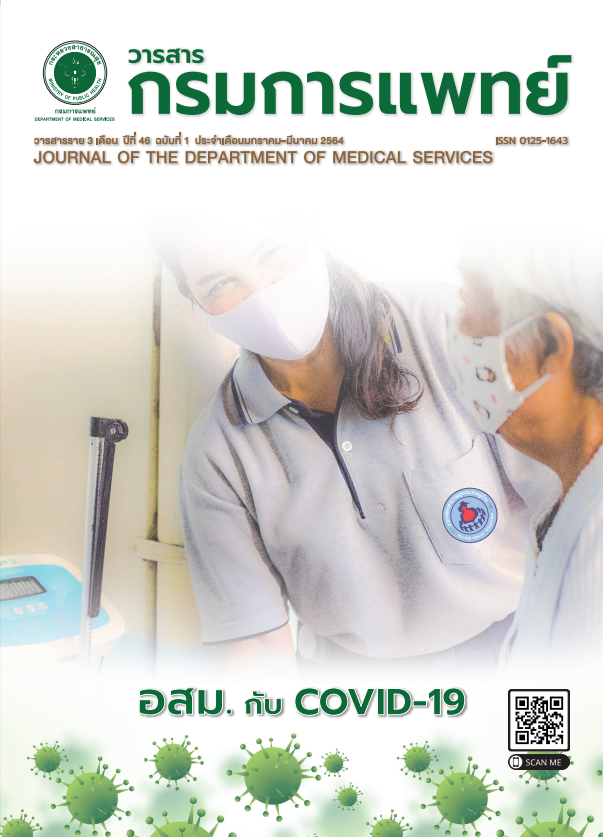การรักษามะเร็งของต่อมน้ำลาย submandinbular ด้วยวิธีผ่าตัดแบบ en bloc และ pectoralis major myocutaneous flap: รายงานผู้ป่วย
คำสำคัญ:
มะเร็งของต่อมน้ำลาย submandibular, การการปลูกถ่ายเนื้อเยื่อข้างเคียงชนิด, pectoralis major myocutaneous flapบทคัดย่อ
นับตั้งแต่มีการพัฒนาเทคนิคการผ่าตัดแบบจุลศัลยกรรมจนเป็นที่แพร่หลายในในปัจจุบัน การผ่าตัดปลูกถ่ายเนื้อเยื่อแบบ free flaps ซึ่งเป็นการย้ายเนื้อเยื่อจากตำแหน่งเดิมไปปลูกถ่ายในตำแหน่งใหม่โดยใช้เทคนิคทางจุลศัลยกรรม ถือเป็นมาตรฐานใหม่ในการ ทำศัลยกรรมตกแต่งและเสริมสร้าง แต่วิธีผ่าตัดแบบ free flaps ยังมีข้อเสียหลายประการเมื่อเปรียบเทียบกับการใช้ regional flap แบบดั้งเดิม เช่นการเข้าถึงอุปกรณ์ ระยะเวลาการผ่าตัดที่ยาวนาน และเทคนิคการผ่าตัดที่ยุ่งยากกว่า วัตถุประสงค์ของรายงานฉบับนี้ คือ แสดงถึงประโยชน์ของการใช้การปลูกถ่ายเนื้อเยื่อข้างเคียงชนิด pectoralis major myocutaneous flap ซึ่งเป็นการใช้เทคนิคการ ผ่าตัดแบบไม่ต้องใช้วิธีทางจุลศัลยกรรมในผู้ป่วยมะเร็งของต่อมน้ำลาย submandibular ด้านขวา กรณีศึกษา เป็นผู้ป่วยหญิง อายุ 41 ปี มาโรงพยาบาลก้อนโตช้าที่บริเวณใต้คางขวา ผลการวินิจฉัยด้วยเทคนิคการย้อมพิเศษทางอิมมูโนฮิสโตเคมี พบเป็นมะเร็งของต่อมน้ำลาย ชนิด salivary duct carcinoma ผู้ป่วยได้รับการผ่าตัดต่อมน้ำลายด้านขวา และทำการผ่าตัด en bloc เนื้อเยื่อบริเวณข้างเคียงทำให้มี แผลเปิดขนาดใหญ่เป็นรูปสามเหลี่ยมขนาด 20x15x14 ซม.ศัลยแพทย์ทำการผ่าตัดปิดแผลด้วยการใช้เนื้อเยื่อข้างเคียงชนิด pectoralis major myocutaneous flap การติดตามผลการรักษาพบว่า รูปร่างและการทำงานของเนื้อเยื่อที่ปลูกถ่ายเป็นไปด้วยดีหลังการผ่าตัด
เอกสารอ้างอิง
Ariyan S. The pectoralis major myocutaneous flap. A versatile flap for reconstruction of the head and neck. Plast Reconstr Surg 1979; 63:73–80.
Spiro RH. Salivary neoplasms: overview of a 35-year experience with 2,807 patients. Head Neck Surg 1986;8:177–84.
Liu R, Gullane P, Brown D, Irish J. Pectoralis major myocutaneous pedicled flap in head and neck reconstruction: retrospective review of indications and results in 244 consecutive cases at the Toronto General Hospital. J Otolaryngol 2001;30: 34–40.
Teo KG, Rozen WM, Acosta R. The pectoralis major myocutaneous flap. J Reconstr Microsurg 2013; 29, 449–56.
Vartanian JG, Carvalho AL, Carvalho SM, Mizobe L, Magrin J, Kowalski LP. Pectoralis major and other myofascial/myocutaneous flaps in head and neck cancer reconstruction:experience with 437 cases at a single institution. Head Neck 2004;26:1018–23.
Granzow JW, Suliman A, Roostaeian J, Perry A, Boyd JB.Supraclavicular artery island flap (SCAIF) vs free fasciocutaneous flaps for head and neck reconstruction. Otolaryngol Head Neck Surg 2013; 148:941–8.
O’Neill JP, Shine N, Eadie PA, Beausang E, Timon C. Free tissue transfer versus pedicled flap reconstruction of head and neck malignancy defects. Ir J Med Sci 2010; 179:337–43.
Wahlberg P, Anderson H, Biorklund A, Moller T, Perfekt R. Carcinoma of the parotid and submandibular glands–a study of survival in 2,465 patients. Oral Oncol 2002; 38:706–13.
Preuss SF, Klussmann JP, Wittekindt C, Drebber U, Beutner D,Guntinas-Lichius O. Submandibular gland excision: 15 years of experience. J Oral Maxillofac Surg 2007; 65: 953–7.
Strick MJ, Kelly C, Soames JV, Mclean NR. Malignant tumours of the minor salivary glands – a 20 years review.Br J Plast Surg 2004; 57:624–31.
Xie S, Yang H, Bredell M, Shen S, Huijun Y, Jin L, et al. Salivary duct carcinoma of the parotid gland: A case report and review of the literature. Oncology lett 2015; 9:371–4.
Chandrasekar C, Salati N, Rao L, Radhakrishnan R. Salivary duct carcinoma in the mandibular anterior region:The role of immunohistochemical markers in its definitive diagnosis. J Oral Maxillofac Pathol 2016; 20:505–9.
Hinni ML, Ferlito A, Brandwein-Gensler MS, Takes RP, Silver CE,Westra WH et al. Surgical margins in head and neck cancer: a contemporary review. Head Neck 2013; 35:1362–70.
ดาวน์โหลด
เผยแพร่แล้ว
รูปแบบการอ้างอิง
ฉบับ
ประเภทบทความ
สัญญาอนุญาต

อนุญาตภายใต้เงื่อนไข Creative Commons Attribution-NonCommercial-NoDerivatives 4.0 International License.
บทความที่ได้รับการตีพิมพ์เป็นลิขสิทธิ์ของกรมการแพทย์ กระทรวงสาธารณสุข
ข้อความและข้อคิดเห็นต่างๆ เป็นของผู้เขียนบทความ ไม่ใช่ความเห็นของกองบรรณาธิการหรือของวารสารกรมการแพทย์



